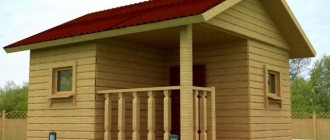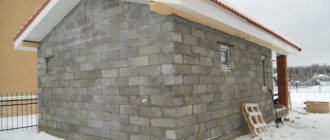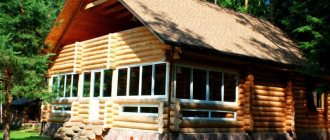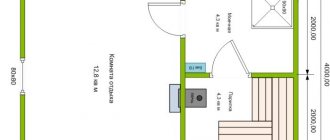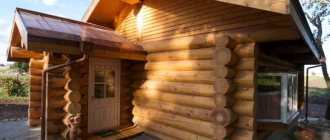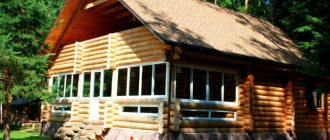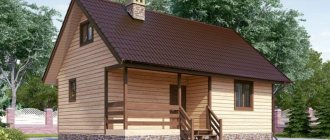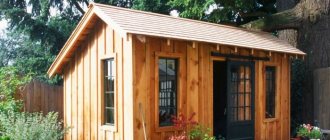Previously, the bathhouse was used to cleanse the body, today visiting the bathhouse is primarily a relaxation in nature. People go to the steam room, then breathe fresh air outside and make barbecue. For this reason, most of those who plan to build a bathhouse choose the option of designing a bathhouse with a terrace.
Advantages of a bathhouse with a terrace, veranda
A veranda is a small open or closed structure with a roof. It is part of the bath structure, located on the same foundation. The veranda is built together with the bathhouse or later. The terrace has its own foundation, another foundation raised above the ground. Such a platform is closed, open, universal. The latter option is suitable for full use both in summer and winter.
A bathhouse with a veranda or terrace has many advantages:
- on the area in front of the bathhouse you can organize barbecue, barbecue, and grilling;
- friendly gatherings, family lunch or dinner are also convenient here;
- a huge selection of modern building materials and design solutions allows you to create a building in any style;
- the extension can be located either on the side of the bathhouse or between the house and the bathhouse, so that you can relax without going far;
- plants in tubs and flowerpots will be beautifully placed on the site;
- competently executed construction allows you to comply with the chosen concept of landscape design as much as possible, without making the architectural ensemble disjointed;
- since there is no need to build a separate roof over the recreation area and the washing area, as well as to connect them with paths, the savings in time and building materials are obvious;
- from the open terrace or veranda you can admire the sunset or sunrise over a cup of tea, wrapped in a soft blanket;
- The outdoor pool can easily be located right on the terrace.
On a standard platform there is a barbecue grill, a barbecue grill, an open stone or brick hearth, several benches or full-fledged chairs, as well as tables.
Choosing a location for the building
The location for the bathhouse should be chosen very carefully, especially when the area is small and the neighbors are very close. If there is such an opportunity, the bathhouse is placed near a natural or artificial reservoir; plunging into cool waters immediately after a hot steam room is a great pleasure.
According to current standards, the following minimum distances to other buildings are required:
- from a residential building – 7-10 m;
- to buildings made of non-combustible material - 6-9 m;
- to wooden outbuildings – 10-13 m;
- to wooden buildings with non-flammable coating - 7-9 m;
- from the roadway – 6-7 m;
- from a neighbor’s fence or boundary – 1-2 m;
- to the neighbor’s house – 15-17 m;
- to the forest – 16 m;
- to the well, well - 10 m;
- to tall trees – 4 m, bushes – 2 m.
It is also important to discuss in advance the location of the future bathhouse in relation to common areas, if any - a swimming pond, a playground, etc. When building on the banks of a river or lake, it is important that waste water does not get there, and that the structure itself stands on solid ground and does not could be damaged during floods.
Even a tall bathhouse will be placed so as not to shade the neighbor’s property. The slope of the bathhouse roof is made in its own direction, and the entrance should be visible from the house, which is very important during kindling.
Peculiarities
When designing a mini-sauna complex with a gazebo, you should consider connections and load distribution. The quality of construction and service life depend on the foundation. Among all the base options, the most popular was the strip one. It is suitable for both small and large structures. The roof of the building is made light, because the part of the building that is the gazebo weakly or does not perform a load-bearing function at all. There are no restrictions in terms of form. Baths are usually built from wood or timber, and in the second case, independent construction is possible. In the case of wooden buildings, it is not necessary to increase energy efficiency. An important point in planning a building and premises is the arrangement of furniture and fixtures inside. Given the influence of humid and warm air, good ventilation and waterproofing will be required.
Selection of materials for construction
Materials for construction are selected mainly as environmentally friendly, natural, and high quality as possible. The structure is built to last for many years, maintaining a beautiful appearance, requiring virtually no repairs.
The following building materials are most often used for construction:
- natural wood - logs, boards, beams;
- brick, natural stone;
- foam concrete, gas silicate blocks;
- glass, including fireproof, frosted, colored;
- sand, gravel, clay, cement;
- various types of vapor barrier, waterproofing, thermal protection;
- pipes made of plastic, metal;
- ceramic tiles - for decorating floors and walls;
- tiles, ondulin, roofing felt, slate - for roofing.
The indoor bathhouse is exposed to hot water and high temperature, while the open area in front of it is exposed to wind, precipitation, and direct sunlight, which is important to consider during construction. For the construction of the bathhouse itself, coniferous wood is preferred, but it is better to finish it with deciduous wood - resinous substances, with long-term exposure, have a detrimental effect on the respiratory system. Such construction is carried out frame or in the form of a log house. Brick, stone, and also bathhouses built using the “claystone” technology (from firewood and clay) are less common.
Since there is always high humidity in the room, high-quality putty of walls, ceilings, and floors is necessary.
Which floor to choose for your future terrace
The choice of flooring depends on the materials from which the entire structure is made and its stylistic design.
Basic requirements for installing a floor on a sauna porch, veranda, terrace:
- the coating should not slip - this will help avoid injuries if the floor is wet;
- the material chosen is frost-resistant, which is important in the coldest regions;
- high resistance to abrasion and deformation - people walk around the site in a variety of shoes.
When the site is partially or completely open, when making the floor it is necessary to make a slight slope (no more than two to four degrees) towards the street so that water can easily flow down.
It is desirable that the entrance to the site can be made both from the street and from the bathhouse building.
Stone, tile or wood
The most popular covering option is decking. It is made from natural wood or wood with the addition of polypropylene. The latter option is characterized by low swelling and practically does not deform from external influences. The most commonly used wood species are larch, ash, spruce, pine, hornbeam, oak, and less commonly - fir, Brazil walnut, cedar, and teak. The use of natural or artificial stone and ceramic tiles is justified if the washing facility is at least partially decorated by them. When using tiles, choose the most textured one that will not slip. In brick buildings, the floor is sometimes made of paving slabs, which visually connect the area with the paths in the garden. Porcelain tiles are also acceptable, it is only important to lay it according to all the rules.
Choosing a decking board
When making a wooden floor on a terrace yourself, it is recommended to cover it with antiseptics, moisture-resistant or fire-resistant impregnations, products containing oils and wax, intended for outdoor use. All of them are available in transparent, tinted or with a whitening effect.
Purchased terrace boards can be smooth or corrugated - for bath verandas and terraces, the latter is recommended. A board made of composite material contains wood flour obtained from valuable wood species and various polymers.
Design
The veranda attached to the bathhouse provides two entry options: internal, from the bathhouse, and external, from the street. It is often built along a long wall and comes in square, rectangular and semicircular designs.
When building an extension on support pillars, a technological gap of 10 mm must be maintained between it and the bathhouse.
Taking into account the location in relation to the bathhouse, the building can be:
- lateral - located along the wall;
- frontal - erected to the front of the building;
- corner - located at the junction of permanent wall structures;
- encircling - built around the perimeter of the building;
- semicircular - completely connected to the bathhouse with an internal exit.
Modern designs of bathhouses with verandas involve the construction of an extension in the shape of a rectangle or square, less often an oval or semicircle.
Materials
Traditionally, when building extensions for brick and wooden baths, rounded logs and timber are used. Such materials are environmentally friendly, durable, and also have high performance characteristics.
Important! For construction, high-quality and well-dried wood with a minimum shrinkage rate is used.
Logs and beams are prepared from coniferous and hardwood trees, pre-treated with antiseptic compounds.
For interior decoration, it is recommended to choose linden, cedar and aspen lining.
In addition to wooden planks, artificial and natural stone, porcelain stoneware, paving and ceramic tiles can be laid as flooring.
Roofing materials require special attention, in particular if the roofs of the veranda and bathhouse have a common design. For the extension, you can use slate, metal tiles, steel sheets, ondulin and polycarbonate.
Foundation
How to attach a veranda to an existing bathhouse quickly and efficiently? Construction work begins with the preparation of a strong and durable foundation, which is designed to protect the finished structure from subsidence and deformation.
The addition of a veranda to a bathhouse can be done on the following types of foundations:
- Tape. It is a reinforced concrete base, running along the perimeter of the construction site on which the construction of an extension is planned. It is suitable for stable types of soil with low groundwater level and can withstand heavy structures.
- Columnar. It is erected from strong supports buried 75 cm into the ground in increments of 2 meters. Asbestos-cement pipes or bored-type piles can be used as supports. Requires additional waterproofing of supports.
- Pile-screw. It is erected from metal pipes equipped with end blades. They are screwed into the ground to the required depth with pre-treatment with an anti-corrosion compound.
- Pile. The most affordable type of base, which is used for problematic soils. The basis is bored concrete piles.
The choice of a suitable foundation for the veranda is determined by the type of foundation on which the bathhouse is built. The finished base is covered with waterproofing material, after which the frame and flooring are assembled.
Walls
The most affordable option is to build a frame veranda for the bathhouse from logs or timber measuring 100 × 150 mm or 100 × 100 mm. Construction work is carried out using the following technology:
- A grillage is laid on top of the waterproofing layer of the foundation base - a wooden frame 55 mm thick and up to 160 mm wide. The strapping is fixed to the base with metal anchors.
- Afterwards, vertical supports are installed - with a notch or metal corners. The racks are fixed on each side to provide the necessary structural rigidity.
- Vertical racks are mounted so that the window and door openings are located between them in the right place.
- The top trim is performed according to a similar pattern. In the outer corners, the logs are joined by notches or corners.
- Wall surfaces are insulated with mineral or basalt wool, and the outside is sheathed with planed boards or decorative panels.
Glazing
The sauna veranda can have partial or full glazing. Each of these options has its own technical features.
- Partial. It is represented by wall structures, which consist of 1/3 of brickwork or a wooden base, the rest of the volume is made of glass. A large number of windows provide additional natural light, making the room more spacious and open.
- Complete. The wall structures consist almost entirely of frames with installed panoramic windows equipped with vents for natural ventilation.
Roof
The design of the roof depends on the location and shape of the veranda itself. If the extension is located under the bathhouse gable, it is easier to arrange a common roof. In this case, there is no need to organize an additional drainage system.
If the veranda is perpendicular to the gable of the bathhouse, a separate roof should be installed.
Now let's look at how to make a roof for a veranda. The assembly is performed as follows:
- The roof truss system is being installed.
- Hydro- and vapor barrier is installed.
- The wooden sheathing is fixed, taking into account the overhangs and ebbs for the pediment.
- Roofing material is being laid.
- An apron is installed at the junction of the veranda and the bathhouse.
Important! The roofing material must be similar to that mounted on the bathhouse.
Building sizes
A modern bathhouse is not only a steam room, a washing room, but also a whole complex that can also combine a relaxation room, a kitchen, a toilet, and a small bedroom. Such a structure, if necessary, can become a full-fledged summer home. The bath terrace will have a barbecue area, a fireplace, and even a small swimming pool.
When drawing up a plan, it is important to take into account many rules and principles for the construction of such structures. The minimum comfortable area of the steam room is 9-11 meters, height – from two. Doors and windows are made on the south, or at least on the east side, to minimize heat loss. All electrical appliances, wires, sockets, switches, if provided, must be protected from moisture to avoid electric shock if they malfunction.
The choice of a suitable project depends on how large the area is around the house:
- 6 by 9 meters are “classic”, the optimal size of a bathhouse in a spacious yard. The guest area here is so large that it can accommodate not only a family of four to six people, but also a dozen friends. It is recommended to build a common foundation for both zones; you can even organize a second floor: then there will be a sauna and a veranda itself below, and a billiards room or a relaxation room, a toilet above;
- The bathhouse attached to a residential building has dimensions of 6 by 6 or 5 by 6 meters - such proportions look harmonious on any standard site. The construction allows you to significantly increase the area of the house, creating a cozy place under a canopy for gatherings with family and friends. An undoubted advantage here is additional protection from the cold of the building itself;
- 4 by 4 or 4 by 4.5 meters is also a typical bathhouse, consisting of a steam room, a font, and a relaxation area. The veranda is located on its own foundation - it is usually open, which is not very convenient, provided that the entrance is from the street. In some options, the structure is made covered or part of the room is converted into a small dressing room;
- in a 4 by 6 meter bath project, a vestibule is provided immediately, since the building is intended to be used in the autumn-winter period. The shower here is not combined with a steam room, but they are almost the same size - the latter is always a little larger, since it must accommodate at least two or three people at the same time;
- a typical bathhouse 5 by 6 meters has a protruding terrace and a fenced dressing room, which takes up very little space. The veranda is designed as an extension, sometimes it is L-shaped, which allows you to comfortably accommodate a large company by arranging a convenient barbecue corner, fireplace or tea area;
- the 6 by 6 meter bathhouse project has a spacious steam room, shower, locker room, vestibule, a place to relax or even a small bedroom. You can also set up a smoking room here. The terrace can be closed or open.
Peculiarities
A large number of people prefer two-story baths, because with their help you can significantly reduce construction costs.
Moreover, this type of design will allow you to combine several separate zones in one room. Quite often, designers include spacious terraces in projects of these structures. The project can either be done with your own hands or ordered from special construction companies. Such structures will be able to emphasize the beauty and elegance of the bathhouse building and the entire summer cottage as a whole.
Many repair specialists recommend that consumers build two-story bathhouses on their land plots, because such buildings have a number of important positive qualities:
- Multifunctionality. These structures will not take up too much space, but at the same time they will be able to accommodate a variety of rooms (gym, storage room, workshop, place for billiards).
- Great appearance. Two-story buildings of this type will look great on almost any suburban area and can give it a beautiful, sophisticated accent.
- Possibility of installing a swimming pool. These baths will allow owners to easily build a swimming pool. As a rule, it is installed on the second, free floor.
- Lightweight thermal insulation of the upper tier. It is not at all necessary to carry out complex procedures for insulating the second floor, because the hot steam from the steam room will rise higher and warm up the space.
Foundation for bathhouse and terrace
The heavier the planned structure, the stronger the foundation for it is made. During simultaneous construction, in most cases, the foundation for the veranda and the bathhouse itself is completed at the same time, but since the shrinkage for both structures varies greatly, a rigid connection between them should be avoided. Any distortions or cracks, if they occur, are masked with polyurethane foam.
The following foundations are used as a reliable foundation:
- columnar - consists of concrete pillars that are dug in several places around the perimeter, to a depth of 55-75 cm. The distance between them should be at least 130-200 cm. Bored piles are sometimes used instead;
- strip is a concrete strip running along the entire perimeter of the building. The design requires a lot of materials and time, so it is used relatively rarely;
- slab - is a “cushion” of concrete used for construction on “soft” soil. Such a foundation is expensive, but the most reliable and durable.
Popular layouts, options for placing terraces
Before starting construction, you must create a project indicating all dimensions. The layout of a bathhouse with a terrace can be closed, open, corner, can be one-story or have a second floor, rest rooms, extensions, sliding doors.
The terrace is arranged in three different ways:
- in front of the entrance - this layout allows you to clearly zone the space;
- separate from the bathhouse - usually next to the pool;
- along the entire perimeter of the building - plays the role of a fence, usually completely covered with a roof.
Bathhouse with a regular terrace
An open area is ideal for the warm season. A portable barbecue and sun loungers will be placed on it. There are usually no side walls or any fences here, and under the roof there is only a woodshed, the size of which depends on how often the bathhouse is used and the total supply of firewood.
Bathhouse with closed terrace
The closed area is fully used all year round. It is decorated with glass walls, a transparent or translucent roof. A barbecue stove, miniature fountains, plants in tubs and flowerpots are carefully placed here. The building must be insulated, and the recreation room is moved to the terrace, and the woodshed is located there. If space allows, you can equip a full-fledged gym.
Corner type with terrace
The main advantage of such a bathhouse is that the only stove is located almost in the center, heating all rooms at the same time, which is especially important in the cold season. Such buildings are often placed in small areas, significantly saving space or “bypassing” large objects such as trees and poles. The finished structure looks stylish and original.
With terrace and barbecue
The building is not only a bathhouse combined with a resting place, but also a full-fledged summer kitchen, which has everything you need. Here it is important to design the chimney competently and beautifully - it must remove smoke efficiently, and also leave room for free movement of the person who will be doing the cooking. The stove itself, as well as the area around it, is usually made of natural stone.
Two-story bathhouse
A two-story structure significantly saves space in a small area. A sauna, washroom, and locker room are located on the first floor, and a place to relax is on the second. The upper floor is decorated with a “broken” roof, allowing full use of almost the entire attic area. The larger the area of the building, the more time it will take to warm it up properly.
With terrace and lounge
The main emphasis here is on the design of the rest room. Usually it is made quite spacious, capable of accommodating up to ten people. In such a room there is a billiard table or a couple of exercise machines, a table and soft sofas, and a real or electric fireplace. A table with chairs can also be placed on the veranda - many people prefer to relax in the fresh air after a hot sauna.
Two-story with an open attic
Such a building will require significant financial investments, since it is impossible to make it small: the average area of the structure, where everything necessary is compactly located, is 30-45 square meters. m. The attic on the second floor is sometimes closed, but more often it is equipped with a spacious, cozy balcony that can be glazed. Here you will need a lot of space for the stairs to the top; it is also important to think through a heating system for such a large bathhouse.
With sliding wall
Sliding walls in the bathhouse are a newfangled invention that is gaining popularity every year. In fact, this is a closed veranda, which becomes open when the wall is pulled back. Sliding structures are made from various materials - plastic, glass, plywood, textiles stretched over a frame, metal. Often used are peculiar “accordions” in the Japanese style, removable shields that move away much like awnings.
With attached gazebo
The gazebo, located under a common roof with the bathhouse, is a neat canopy over the dining area. To make it more convenient to enter and exit the gazebo, the floor level is made the same in both zones. The roof of the building is made single-slope, gable, multi-slope, the gazebo itself is quadrangular, round, octagonal, etc. An outdoor fireplace, barbecue, barbecue are also installed here, and soft chairs or wooden benches are placed.
Terrace between the bathhouse and the house
For lovers of winter bathing procedures, a covered area between a residential building and a bathhouse is ideal. This project is acceptable for owners of small plots, and the heating system is made common to the entire building - one stove heats the entire house. The sewage system will also be uniform. A small pool is often located here, decorated with a transparent roof, which allows you to save on lighting during the day. The main thing in such a building is to take care of fire safety; it is advisable to use non-flammable materials, fire-resistant impregnations, and keep fire extinguishers within reach.
Examples
Nothing tells the story of functionality like clear examples. They clearly show the demarcation of spaces for a steam room, washing room, and rest room.
- 4x6 m. Project of a one-story bathhouse with designated areas for a steam room, shower room and rest room 4x4.5 m. At the same time, a space of 4x1.5 m is left for the veranda.
- 6x8 m. This project clearly demonstrates the footage of each room in a bath house with a veranda. For example, an area of 2x6 m is allocated for the veranda; a total area of 8.1 sq. m is provided for the steam room. m, for the washing room - the same. The rest room is 3 by 6 m.
- 6.3x9.7 m. The option demonstrates the location of the doors and the approximate arrangement of furniture. Provides a steam room, shower room, rest room, bathroom, as well as a veranda with a dining area.
- This project is suitable for spacious buildings. It includes a steam room, a bathroom, a vestibule, a common room, a bathroom, a kitchen, a utility room, and a furnace room. A space of 7.1 x 3.7 m is allocated for the veranda.
- 5.4x8 m. Another example with furniture arrangement. Includes a shower room, steam room, relaxation room, vestibule and veranda.
- 5x6 m. Allocating a larger area for a veranda and a rest room, where you can place a cozy guest corner. The project includes a steam room and a washing room.
- 5x4 m. Placement of the main rooms: steam room, washing room, rest room and veranda.
When space is limited to a minimum or the area is non-standard (narrow, for example, 3x6 m), you have to play with the design features of the bathhouse
The arrangement of furniture is made linear, special attention is paid to the side of opening and closing doors, so as not to create restrictions for users. If there is a lack of footage, they stick to more functionality, choosing compact furniture and plumbing fixtures
Do not forget to take into account the angle of inclination of the roof, which is especially important for the lean-to type. Typically, the height of one of the walls with this design does not exceed 1.5 m
Certain difficulties with the placement of furniture, plumbing and necessary accessories can be caused by design options for two-story buildings with an attic. In such cases, you have to carefully consider the location of any interior detail so that it does not deprive the user of comfort
Typically, the height of one of the walls in such a design does not exceed 1.5 m. Certain difficulties with the placement of furniture, plumbing and necessary accessories can be caused by design options for two-story buildings with an attic. In such cases, you have to carefully consider the location of any interior detail so that it does not deprive the user of comfort.
Even the side and method of opening the windows matters. In this case, not only the windows of the bathhouse are taken into account, but also the design of the glazed veranda
This is important for any size of bathhouse and will allow you to ventilate the rooms if necessary, especially if there is a fireplace in the common room or the veranda is equipped as a kitchen. Structures can be tinted with a special film that allows light to pass through, but hides what is happening inside the premises.
By the way, the film can also be used to decorate glass curtains, if such are provided for in the project design. It will allow you to decorate your interior and can imitate different types of materials, including reptile skin and stone. With the right selection of shade and effect, it can give integrity to the bathhouse style and indicate a certain stylistic idea.
Interior Design Ideas
The interior decoration of the bathhouse should be as hygienic and safe as possible. The same applies to the space of the closed terrace. The open area is made resistant to external weather conditions - its parts are varnished and painted in different colors. The cramped the interior spaces, the lighter the finishing is required; to expand the space even more, mirrors are suitable - in wet rooms they are coated with special compounds that prevent fogging.
Wooden buildings are most often decorated with house carvings - they are present on the railings, roof edges, and in the design of windows. To diversify the interior design, wood of different shades is used. The bathhouse, decorated in the style of an old Russian hut, looks interesting - it has the appearance of a log house, with rough “clumsy” interior decor, good-quality benches along the walls, and “antique” wooden tubs. The steam room space itself is prohibited from painting or varnishing - most of these compositions release all kinds of poisons when heated.
The brick bathhouse is decorated with wrought iron railings, stands for firewood, and a fireplace with metal shutter doors. The roof of a building in ethnic style is covered with reeds and straw. A bathhouse in a modern style has practically no decorations - everything that is in it is as simple as possible in form and strictly functional. The round building with a terrace looks very original, but its full design can only be done by true masters of their craft - the interior design, the shape of each room here must be appropriate.
Furniture that suits different styles is made of wood, with forged legs, or wicker rattan. For spacious rooms, as well as for families with children, swing benches will be useful. A flat screen TV or a computer with a game console is sometimes placed in the relaxation room - it is important that such a room does not have high humidity, which can damage expensive electrical appliances.

